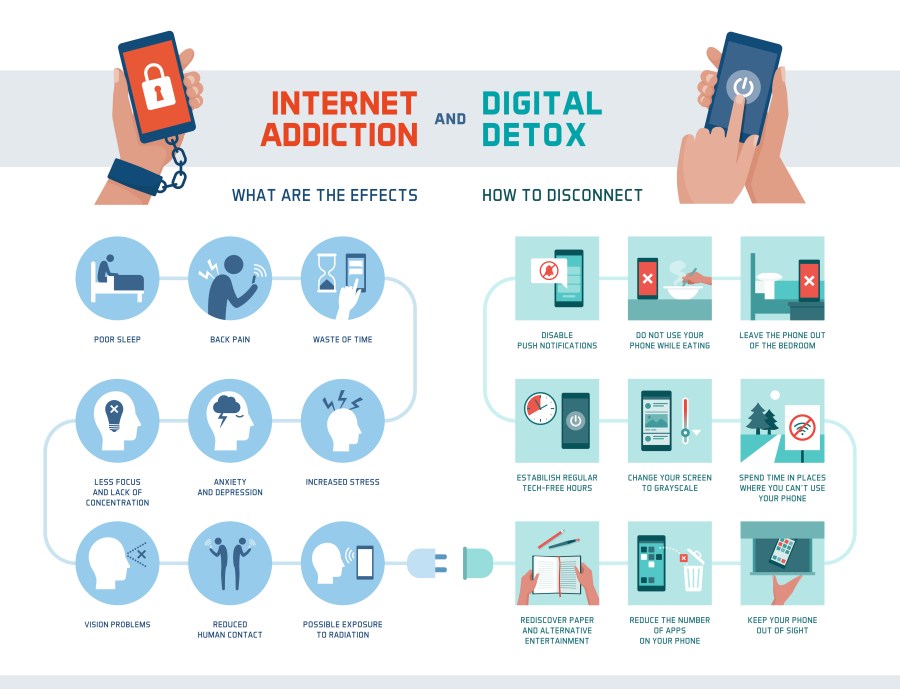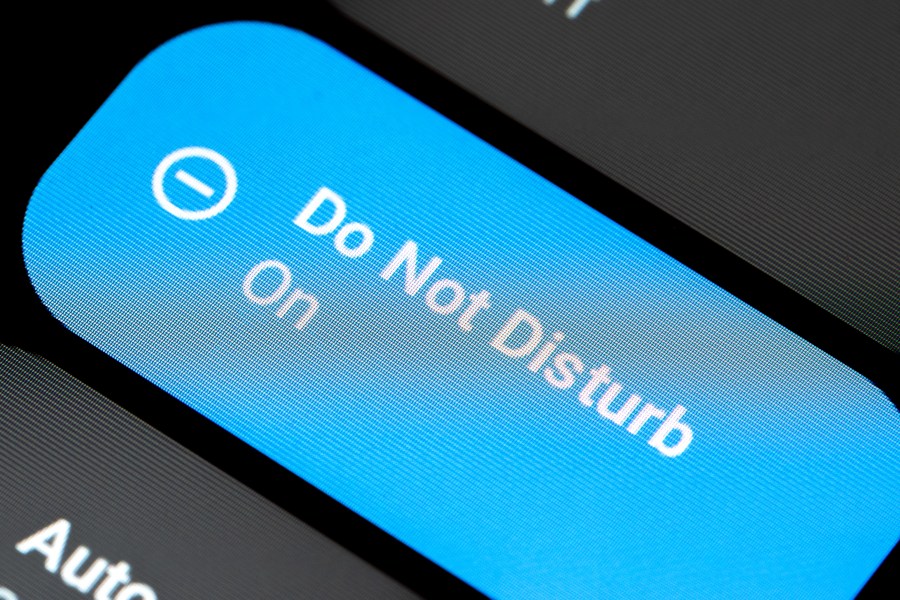In today’s connected world, it’s easy to get swept up in the constant stream of notifications, emails, and social media updates. We’re surrounded by screens and gadgets at all times, and it can be difficult to disconnect and take a break from the digital overload.
That’s where digital detoxing comes in. A digital detox involves taking a break from technology for a set period of time, from a few hours to a few days or more. It’s a way to unplug, recharge, and reconnect with the world around us.
In this article, we’ll explore the benefits of a digital detox, how to do it, and how to make it a habit in your daily life.
The Problem with Digital Overload

Before we dive into the benefits of digital detoxing, let’s take a look at the negative effects of constant digital stimulation.
Research has shown that excessive screen time can lead to a variety of health problems, including eye strain, headaches, neck and back pain, and disrupted sleep patterns. It can also have negative effects on our mental health, contributing to anxiety, depression, and other mood disorders.
Being constantly connected can make it difficult to focus on important tasks and can reduce productivity and creativity. It can also impact our social lives, leading to a decrease in face-to-face communication skills and an increase in social isolation.
What is a Digital Detox?
A digital detox is a period of time when you intentionally disconnect from technology. It can involve turning off your phone, avoiding social media, and avoiding any other forms of digital stimulation.
There are different types of digital detoxes, from short breaks of a few hours to longer breaks of a few days or more. Some people choose to do a full technology fast, while others simply limit their screen time and set boundaries with technology.
Here are some examples:
- Social media detox: This involves taking a break from social media platforms such as Facebook, Instagram, and Twitter. It can help reduce feelings of anxiety, improve sleep, and increase productivity.
- Smartphone detox: This involves reducing or eliminating the use of your smartphone. It can help reduce feelings of FOMO, improve relationships, and increase mindfulness.
- Screen time detox: This involves reducing the amount of time spent in front of screens, including TVs, computers, and smartphones. It can help reduce eye strain, improve sleep, and increase productivity.
- Internet detox: This involves taking a break from the internet altogether, including email, social media, and online news. It can help reduce feelings of overwhelm and improve mental clarity.
- Digital declutter: This involves decluttering your digital life by deleting unnecessary apps and files, unsubscribing from email lists, and organizing your digital files. It can help reduce feelings of overwhelm and increase productivity.
By choosing the type of digital detox that works best for you, you can reap the benefits of disconnecting from technology and reconnecting with the world around you.
What does the science say?
Research has shown that taking a break from technology can have significant benefits for our mental health and wellbeing. Here are some statistics and studies that support the benefits of digital detoxing:
- A 2020 study published in the journal Cyberpsychology, Behavior, and Social Networking found that taking a break from social media for just one week led to significant improvements in participants’ wellbeing, including lower levels of anxiety and depression.
- According to a 2017 study by the American Psychological Association, “constant checkers” of email, texts, and social media reported higher levels of stress compared to those who checked less frequently. The study also found that people who took a break from technology reported feeling more relaxed and less stressed.
- A survey conducted by the National Sleep Foundation found that people who used electronic devices in the hour before bed reported poorer sleep quality than those who did not. Disconnecting from technology before bedtime can improve the quality and quantity of our sleep, which in turn can improve our overall wellbeing.
- According to a 2018 study published in the journal ScienceDirect, people who spent less time on their phones reported feeling more socially connected and less lonely than those who spent more time on their phones.
- A survey conducted by the Center for Humane Technology found that people who limited their social media use reported feeling less distracted, less anxious, and more productive.
These statistics and studies suggest that taking a break from technology can have significant benefits for our mental health, sleep, and social connections. By disconnecting from technology and reconnecting with the world around us, we can improve our overall wellbeing and quality of life.
How to do a Digital Detox

If you’re interested in trying a digital detox, here are some practical tips to get started:
- Choose a specific time period. Decide how long you want to go without technology and set a specific start and end time.
- Prepare ahead of time. Let your friends and family know that you’ll be offline for a while. Set up an automatic email response and update your social media accounts to let people know that you’ll be taking a break.
- Find alternative activities. Plan ahead for what you’ll do instead of spending time on your phone or computer. Activities like reading, exercising, or spending time in nature can be great options.
- Be patient with yourself. It’s normal to feel anxious or uncomfortable at first when disconnecting from technology. Give yourself time to adjust and be kind to yourself throughout the process.
Benefits of a Digital Detox
Now that we’ve covered how to do a digital detox, let’s take a look at the benefits.
- Improved mental health and wellbeing. Disconnecting from technology can help reduce stress and anxiety, and can improve overall mental health and wellbeing.
- Increased productivity and creativity. Taking a break from constant digital stimulation can help improve focus and concentration, leading to increased productivity and creativity.
- Better sleep quality and quantity. Excessive screen time has been linked to poor sleep quality and disrupted sleep patterns. A digital detox can help improve sleep by reducing exposure to blue light and stimulating content.
- Enhanced face-to-face communication skills. Spending less time online can lead to more time for face-to-face interactions, improving communication skills and overall social connectedness.
Downsides of a Digital Detox
While digital detoxing can be a powerful tool for improving mental health and wellbeing, there are also potential downsides to consider. One of the biggest downsides is the risk of missing out on important news or communication with friends and family.
In today’s world, many of us rely on technology to stay connected with our loved ones and to stay informed about important events happening around the world. When we disconnect from technology, we risk missing out on these important connections and updates.
Another potential downside of a digital detox is the challenge of breaking old habits and routines. If you’re used to checking your phone first thing in the morning or scrolling through social media during your lunch break, it can be difficult to adjust to a new routine without technology.
Finally, some people may experience feelings of anxiety, boredom, or FOMO (fear of missing out) during a digital detox. If you’re used to constantly being connected and stimulated by technology, it can be jarring to suddenly disconnect and be left with your own thoughts and emotions.
Despite these potential downsides, it’s important to remember that the benefits of digital detoxing often outweigh the risks. By taking steps to mitigate these downsides, such as designating a trusted emergency contact or finding alternative ways to stay informed, we can reap the rewards of disconnecting from technology and reconnecting with the world around us.
Incorporating Digital Detoxing into daily life
So, now that you know the benefits of digital detoxing, how can you make it a habit in your daily life?
- Start small. You don’t have to go completely offline for days on end to experience the benefits of a digital detox. Start with a few hours or a day and gradually work your way up.
- Set boundaries with technology. Establish rules for when and how you use technology, such as not checking your phone during meals or not using technology after a certain time of day.
- Be intentional with your screen time. Instead of mindlessly scrolling through social media, set aside specific times each day for checking your email, social media, and other online activities.
- Find alternative ways to unwind. Instead of using technology to relax, find other activities that help you unwind, such as reading, journaling, or spending time in nature.
Digital detoxing is a powerful tool for improving mental health, productivity, and overall wellbeing. By disconnecting from technology and reconnecting with the world around us, we can gain a new perspective and recharge our batteries.
So, the next time you feel overwhelmed by the constant barrage of digital stimulation, consider trying a digital detox. Your mind and body will thank you.







